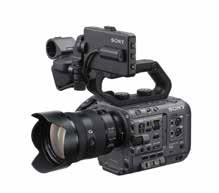FEATURE
WHAT IS IN STORE?
HERE ARE THE TOP TECHNOLOGY TRENDS FOR RETAIL IN THE COMING YEAR
T
he coronavirus crisis has had a disruptive impact on the retail sector. With consumer confidence very low and consumers staying mostly out of stores, many retailers, especially with a large physical footprint, have been forced to go out of business. The pandemic has accelerated the shift from brick-andmortar to online retailing, and the research firm IDC predicts retail technology investments will continue to reflect digital transformation efforts, as retailers reserved the capital for technology investments by reducing spending on store opening and remodels. The Middle East & North Africa (MENA) region has shown the fastest growth for ecommerce compared with other regions around the world, with the United Arab Emirates (UAE) at the hub of the action. According to a report from Visa Middle East, the UAE is the most advanced eCommerce market in the MENA region and sales in the UAE are projected to grow by an average of 23% annually. Digital technologies will no doubt be more important than ever for retailers to offer a seamless experience to customers. There are many technology trends, which 22
CXO INSIGHT ME
DECEMBER 2020
are already taking shape that retail CIOs will have to tackle in 2021. Are retail IT organisations prepared for a tectonic shift in business operations, address disruptions in the supply chain, and support both e-commerce and in-store fulfillment? “Certain industries have leapfrogged their pace of digital transformation, and retail is one of them. With the growing use of emerging technologies, the retail industry has been able to modernise their service delivery model, accelerate automation in process and operation,” says Manish Ranjan, Program Manager for Software and Cloud at IDC Middle East, Turkey and Africa. The retail industry witnessed an explosion in the e-commerce platform where various retail organisations used cloud-based solutions, AI/ML and analytics to have data-driven customer strategies. By leveraging RPA, AI, and intelligent process automation (IPA) to automate back-office and front-office, retail organisations strived to achieve operational rationalisation. Various organisations also invested in modernising their overall supply chain during the current pandemic by revamping their distribution and
delivery system through warehouse automation and strategic delivery partnerships, says Ranjan. “In a fiercely competitive field, where e-shoppers can switch to a competitor with a single click, e-tail firms realise that their digital presence is now an integral part of their brand — they must ensure a digital experience that is slick, reliable, and engaging. As such, the applications that feed user experiences are no longer backroom tools, but vital operational components,” says David Noël, regional vice president, Southern Europe, Middle East & Africa at AppDynamics. He adds retail IT teams need to be familiar with the baseline metrics used to measure the performance of their applications and websites. “It is important to take a fresh look, as they may have changed from last year. It is useful if you can configure your environment to auto-scale itself to cope with surges in user engagement. Also, take time to account for user behaviours. For example, casual browsers have a different impact on your resources than those searching for a specific product.” According to Avinash Gujje, Practice Head – Infrastructure, Cloud Box












